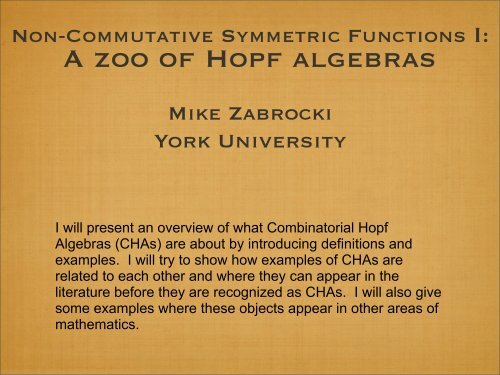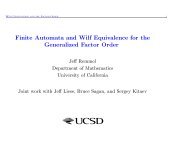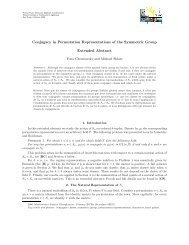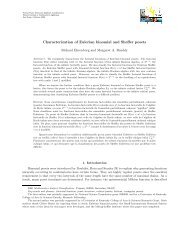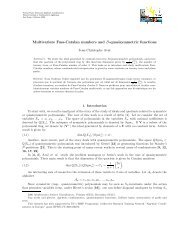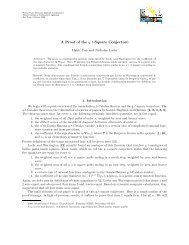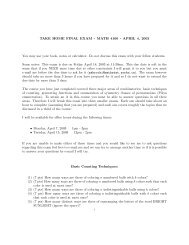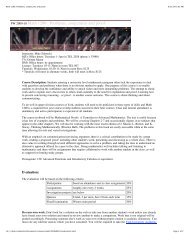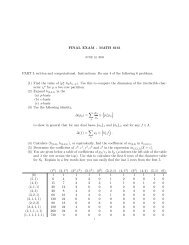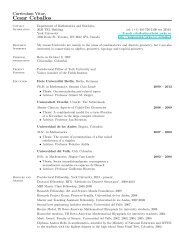A zoo of Hopf algebras - York University
A zoo of Hopf algebras - York University
A zoo of Hopf algebras - York University
You also want an ePaper? Increase the reach of your titles
YUMPU automatically turns print PDFs into web optimized ePapers that Google loves.
Non-Commutative Symmetric Functions I:<br />
A <strong>zoo</strong> <strong>of</strong> <strong>Hopf</strong> <strong>algebras</strong><br />
Mike Zabrocki<br />
<strong>York</strong> <strong>University</strong><br />
I will present an overview <strong>of</strong> what Combinatorial <strong>Hopf</strong><br />
Algebras (CHAs) are about by introducing definitions and<br />
examples. I will try to show how examples <strong>of</strong> CHAs are<br />
related to each other and where they can appear in the<br />
literature before they are recognized as CHAs. I will also give<br />
some examples where these objects appear in other areas <strong>of</strong><br />
mathematics.
Partitions<br />
Unordered lists <strong>of</strong> non-negative<br />
integers
Partitions<br />
Unordered lists <strong>of</strong> non-negative<br />
integers
Partitions<br />
Unordered lists <strong>of</strong> non-negative<br />
integers
Partitions<br />
Unordered lists <strong>of</strong> non-negative<br />
integers
Create an algebra
Create an algebra<br />
linearly spanned by partitions
Create an algebra<br />
linearly spanned by partitions<br />
Commutative product
Create an algebra<br />
linearly spanned by partitions<br />
Commutative product<br />
Graded by size <strong>of</strong> partitions
Create an algebra<br />
linearly spanned by partitions<br />
Commutative product<br />
Graded by size <strong>of</strong> partitions
Create an algebra<br />
linearly spanned by partitions<br />
Commutative product<br />
Graded by size <strong>of</strong> partitions<br />
linear span <strong>of</strong><br />
partitions <strong>of</strong> size
Create an algebra<br />
linearly spanned by partitions<br />
Commutative product<br />
Graded by size <strong>of</strong> partitions<br />
linear span <strong>of</strong><br />
partitions <strong>of</strong> size
Define a commutative product
Define a commutative product
Define a commutative product
Define a commutative product
properties <strong>of</strong> this algebra<br />
Commutative and graded
properties <strong>of</strong> this algebra<br />
Commutative and graded
properties <strong>of</strong> this algebra<br />
Commutative and graded
Properties <strong>of</strong> this algebra<br />
Freely (commutative) generated by building<br />
blocks <strong>of</strong> rows
Properties <strong>of</strong> this algebra<br />
Freely (commutative) generated by building<br />
blocks <strong>of</strong> rows
Properties <strong>of</strong> this algebra<br />
Freely (commutative) generated by building<br />
blocks <strong>of</strong> rows
properties <strong>of</strong> this algebra
properties <strong>of</strong> this algebra<br />
Bilinear
properties <strong>of</strong> this algebra<br />
Bilinear
properties <strong>of</strong> this algebra<br />
Bilinear<br />
Isomorphic to the free polynomial algebra with<br />
one generator at each degree
properties <strong>of</strong> this algebra<br />
Bilinear<br />
Isomorphic to the free polynomial algebra with<br />
one generator at each degree
properties <strong>of</strong> this algebra<br />
Bilinear<br />
Isomorphic to the free polynomial algebra with<br />
one generator at each degree
From combinatorial object<br />
to algebra<br />
partitions
From combinatorial object<br />
to algebra<br />
partitions<br />
some<br />
commutative<br />
product
From combinatorial object<br />
to algebra<br />
partitions<br />
some<br />
commutative<br />
product<br />
Algebra
From combinatorial object<br />
to algebra<br />
partitions<br />
another<br />
commutative<br />
product<br />
Algebra
A different commutative product<br />
And yet the algebra which arises is<br />
isomorphic to
A different commutative product<br />
And yet the algebra which arises is<br />
isomorphic to
This algebra is special
This algebra is special<br />
Just about any algebra with basis<br />
indexed by partitions is Isomorphic:<br />
e.g. symmetric functions,<br />
representation ring <strong>of</strong> symmetric<br />
group, ring <strong>of</strong> characters <strong>of</strong> GLn<br />
modules, cohomology rings <strong>of</strong> the<br />
grassmannians, etc.
This algebra is special<br />
Just about any algebra with basis<br />
indexed by partitions is Isomorphic:<br />
e.g. symmetric functions,<br />
representation ring <strong>of</strong> symmetric<br />
group, ring <strong>of</strong> characters <strong>of</strong> GLn<br />
modules, cohomology rings <strong>of</strong> the<br />
grassmannians, etc.<br />
Has a <strong>Hopf</strong> algebra structure<br />
product + coproduct + antipode<br />
which all interact nicely with each<br />
other
What is a <strong>Hopf</strong> algebra?
What is a <strong>Hopf</strong> algebra?<br />
Start with a Bialgebra
What is a <strong>Hopf</strong> algebra?<br />
Start with a Bialgebra<br />
Product<br />
Coproduct
What is a <strong>Hopf</strong> algebra?<br />
Start with a Bialgebra<br />
Product<br />
Coproduct<br />
with unit<br />
and counit
What is a <strong>Hopf</strong> algebra?<br />
Start with a Bialgebra<br />
Product<br />
Coproduct<br />
with unit<br />
and counit<br />
and an antipode map
What is a <strong>Hopf</strong> algebra?<br />
Start with a Bialgebra<br />
this diagram commutes
What is so good about a <strong>Hopf</strong><br />
algebra?<br />
The graded kind associated with<br />
combinatorial objects have lots <strong>of</strong><br />
structure<br />
There seems to be just “one” graded<br />
combinatorial hopf algebra for<br />
each type <strong>of</strong> combinatorial object<br />
Many <strong>of</strong> the combinatorial<br />
operations are reflected in the<br />
algebraic structure
What is so good about a <strong>Hopf</strong><br />
algebra?<br />
There is “usually” an internal<br />
product structure and on some<br />
bases <strong>of</strong> some <strong>algebras</strong> this is hard<br />
(but important) to explain<br />
Aguiar-Bergeron-Sottile says<br />
A combinatorial <strong>Hopf</strong> algebra is a<br />
graded connected <strong>Hopf</strong> algebra with<br />
a multiplicative linear function.
CHA’s in the mid-90s<br />
the symmetric functions are<br />
commutative and generated by one<br />
element at each degree<br />
partitions
CHA’s in the mid-90s<br />
the symmetric functions are<br />
commutative and generated by one<br />
element at each degree<br />
partitions<br />
Non-commutative symmetric functions<br />
will be non-commutative and generated<br />
by one element at each degree
CHA’s in the mid-90s<br />
the symmetric functions are<br />
commutative and generated by one<br />
element at each degree<br />
partitions<br />
Non-commutative symmetric functions<br />
will be non-commutative and generated<br />
by one element at each degree<br />
compositions
CHA’s in the mid-90s<br />
the symmetric functions are<br />
commutative and generated by one<br />
element at each degree<br />
partitions<br />
Non-commutative symmetric functions<br />
will be non-commutative and generated<br />
by one element at each degree<br />
compositions<br />
concatenation<br />
product
CHA’s in the mid-90s<br />
the symmetric functions are<br />
commutative and generated by one<br />
element at each degree<br />
partitions<br />
Non-commutative symmetric functions<br />
will be non-commutative and generated<br />
by one element at each degree<br />
compositions<br />
concatenation<br />
product
CHA’s in the mid-90s<br />
the symmetric functions are<br />
commutative and generated by one<br />
element at each degree<br />
partitions<br />
Non-commutative symmetric functions<br />
will be non-commutative and generated<br />
by one element at each degree<br />
compositions<br />
concatenation<br />
product<br />
I. Gelfand, D. Krob, A. Lascoux, B.<br />
Leclerc, V. Retakh, and J.-Y. Thibon
CHA’s in the mid-90s<br />
partitions
CHA’s in the mid-90s<br />
partitions<br />
compositions
CHA’s in the mid-90s<br />
partitions<br />
compositions<br />
GKLLRT (ʻ95)
CHA’s in the mid-90s<br />
partitions<br />
compositions<br />
GKLLRT (ʻ95)
CHA’s in the mid-90s<br />
partitions<br />
compositions<br />
compositions<br />
GKLLRT (ʻ95)
CHA’s in the mid-90s<br />
partitions<br />
compositions<br />
compositions<br />
Commutative algebra<br />
<strong>of</strong> Quasi-symmetric functions<br />
GKLLRT (ʻ95)
CHA’s in the mid-90s<br />
partitions<br />
compositions<br />
compositions<br />
Commutative algebra<br />
<strong>of</strong> Quasi-symmetric functions<br />
GKLLRT (ʻ95)<br />
Gessel (ʻ84)
CHA’s in the mid-90s<br />
FQSym
CHA’s in the mid-90s<br />
FQSym
CHA’s in the mid-90s<br />
Malvenuto-Reutenauer (ʻ95)<br />
FQSym<br />
permutations
CHA’s in the 90s+
CHA’s in the 90s+<br />
uniform block permutations<br />
Aguiar-Orellana ‘05
CHA’s in the 90s+<br />
uniform block permutations<br />
Aguiar-Orellana ‘05<br />
Tableaux<br />
7<br />
6<br />
8<br />
4 5<br />
11<br />
9<br />
1 2 3<br />
12<br />
10<br />
14<br />
13<br />
Poirier-Reutenauer ‘95
CHA’s in the 90s+<br />
binary trees Connes-Kreimer ’98<br />
Grossman-Larson ‘89<br />
Loday-Ronco ‘98<br />
uniform block permutations<br />
Aguiar-Orellana ‘05<br />
Tableaux<br />
7<br />
6<br />
8<br />
4 5<br />
11<br />
9<br />
1 2 3<br />
12<br />
10<br />
14<br />
13<br />
Poirier-Reutenauer ‘95
CHA’s in the 90s+
CHA’s in the 90s+<br />
Signed Compositions<br />
Mantaci-Reutenauer ‘95
CHA’s in the 90s+<br />
Signed Compositions<br />
Mantaci-Reutenauer ‘95<br />
Packed Words<br />
Set Compositions<br />
Hivert ‘99
CHA’s in the 90s+<br />
Signed Compositions<br />
Mantaci-Reutenauer ‘95<br />
Parking Functions<br />
3<br />
3<br />
2<br />
2<br />
1<br />
3<br />
1<br />
Novelli-Thibon ‘04<br />
Packed Words<br />
Set Compositions<br />
Hivert ‘99
A <strong>zoo</strong> <strong>of</strong> <strong>Hopf</strong> Algberas<br />
3<br />
1<br />
2<br />
1<br />
3<br />
2<br />
3<br />
7<br />
6<br />
8<br />
4 5<br />
11<br />
9<br />
1 2 3<br />
12<br />
10<br />
14<br />
13<br />
<strong>Hopf</strong>’s<br />
graded
A goal <strong>of</strong> research on<br />
graded <strong>Hopf</strong> <strong>algebras</strong>?<br />
One Goal <strong>of</strong><br />
determining the <strong>Hopf</strong><br />
<strong>algebras</strong> associated to<br />
combinatorial objects<br />
is to try and arrive at<br />
a classification<br />
theorem for Graded<br />
combinatorial <strong>Hopf</strong><br />
<strong>algebras</strong><br />
A CLassification<br />
Theorem<br />
7<br />
6<br />
8<br />
4 5<br />
11<br />
9<br />
1 2 3<br />
12<br />
10<br />
14<br />
13
A goal <strong>of</strong> research on<br />
graded <strong>Hopf</strong> <strong>algebras</strong>?<br />
One Goal <strong>of</strong><br />
determining the <strong>Hopf</strong><br />
<strong>algebras</strong> associated to<br />
combinatorial objects<br />
is to try and arrive at<br />
a classification<br />
theorem for Graded<br />
combinatorial <strong>Hopf</strong><br />
<strong>algebras</strong><br />
Aguiar<br />
Species CHAs<br />
A CLassification<br />
Theorem<br />
7<br />
6<br />
8<br />
4 5<br />
11<br />
9<br />
1 2 3<br />
12<br />
10<br />
14<br />
13
A goal <strong>of</strong> research on<br />
graded <strong>Hopf</strong> <strong>algebras</strong>?<br />
One Goal <strong>of</strong><br />
determining the <strong>Hopf</strong><br />
<strong>algebras</strong> associated to<br />
combinatorial objects<br />
is to try and arrive at<br />
a classification<br />
theorem for Graded<br />
combinatorial <strong>Hopf</strong><br />
<strong>algebras</strong><br />
Aguiar<br />
Species CHAs<br />
(N)Bergeron-Lam-Li<br />
Rep theory<br />
A CLassification<br />
Theorem<br />
7<br />
6<br />
8<br />
4 5<br />
11<br />
9<br />
1 2 3<br />
12<br />
10<br />
14<br />
13
<strong>Hopf</strong> <strong>algebras</strong> <strong>of</strong> set<br />
partitions/compositions
<strong>Hopf</strong> <strong>algebras</strong> <strong>of</strong> set<br />
partitions/compositions
<strong>Hopf</strong> <strong>algebras</strong> <strong>of</strong> set<br />
partitions/compositions<br />
Set composition definition:
<strong>Hopf</strong> <strong>algebras</strong> <strong>of</strong> set<br />
partitions/compositions<br />
Set composition definition:<br />
Set partition definition:
Another type <strong>of</strong> non-commutative<br />
symmetric functions<br />
Invariants under the left action<br />
on the polynomial ring<br />
Free algebra generated by one<br />
element at each degree<br />
Invariants under the left action<br />
on the non-comm poly ring<br />
Wolf 1936, Rosas-Sagan ’03
Monomial set partition<br />
For each monomial<br />
Associate a set partition
Example:
Example:
Example:
Example:<br />
This is a non commutative polynomial<br />
for a given
Example:<br />
This is a non commutative polynomial<br />
for a given<br />
Consider the elements<br />
to be the object by letting the<br />
number <strong>of</strong> variables<br />
in
Combinatorial rule<br />
for product
Combinatorial rule<br />
for product
Combinatorial rule<br />
for product
Coproduct<br />
Inspiration:
Coproduct<br />
Inspiration:
Coproduct<br />
Inspiration:
Definition <strong>of</strong><br />
Non-commutative<br />
Co-commutative<br />
<strong>Hopf</strong> algebra <strong>of</strong> set partitions
Analogy between Sym and NCSym
Properties <strong>of</strong> NCSym
Properties <strong>of</strong> NCSym<br />
Non-commutative and co-commutative
Properties <strong>of</strong> NCSym<br />
Non-commutative and co-commutative<br />
Has bases analogous to power,<br />
elementary, homogeneous, monomial<br />
symmetric functions in the algebra <strong>of</strong><br />
Sym (Rosas-Sagan ’03, Bergeron-Brlek)
Properties <strong>of</strong> NCSym<br />
Non-commutative and co-commutative<br />
Has bases analogous to power,<br />
elementary, homogeneous, monomial<br />
symmetric functions in the algebra <strong>of</strong><br />
Sym (Rosas-Sagan ’03, Bergeron-Brlek)<br />
The dimension <strong>of</strong> the part <strong>of</strong> degree n<br />
are the bell numbers<br />
1, 1, 2, 5, 15, 52, 203, 877, 4140, ...
Some questions to ask
Some questions to ask<br />
what is a fundamental basis <strong>of</strong> this space<br />
(analogue <strong>of</strong> Schur basis)?
Some questions to ask<br />
what is a fundamental basis <strong>of</strong> this space<br />
(analogue <strong>of</strong> Schur basis)?<br />
What is the connection with<br />
representation theory?
Some questions to ask<br />
what is a fundamental basis <strong>of</strong> this space<br />
(analogue <strong>of</strong> Schur basis)?<br />
What is the connection with<br />
representation theory?<br />
What is the structure <strong>of</strong> this algebra?
Some questions to ask<br />
what is a fundamental basis <strong>of</strong> this space<br />
(analogue <strong>of</strong> Schur basis)?<br />
What is the connection with<br />
representation theory?<br />
What is the structure <strong>of</strong> this algebra?<br />
What is the relationship with the ‘other’<br />
non-commutative symmetric functions?<br />
(NSym)<br />
compositions set partitions
The connection between<br />
NSym and NCSym<br />
NCSym has graded dimensions<br />
1, 1, 2, 5, 15, 52, 203, 877, 4140, ...<br />
NSym has graded dimensions<br />
1, 1, 2, 4, 8, 16, 32, 64, 128, ...
The connection between<br />
NSym and NCSym<br />
NCSym has graded dimensions<br />
1, 1, 2, 5, 15, 52, 203, 877, 4140, ...<br />
NSym has graded dimensions<br />
1, 1, 2, 4, 8, 16, 32, 64, 128, ...<br />
There exists a <strong>Hopf</strong> morphism
Families <strong>of</strong> morphisms
Families <strong>of</strong> morphisms
7<br />
6<br />
8<br />
4 5<br />
11<br />
9<br />
1 2 3<br />
12<br />
10<br />
14<br />
13<br />
3<br />
1<br />
2<br />
1<br />
3<br />
2<br />
3
One last open question
One last open question<br />
What is the <strong>Hopf</strong> algebra <strong>of</strong> lions?
One last open question<br />
What is the <strong>Hopf</strong> algebra <strong>of</strong> lions?
One last open question<br />
What is the <strong>Hopf</strong> algebra <strong>of</strong> lions?<br />
Rowr!


